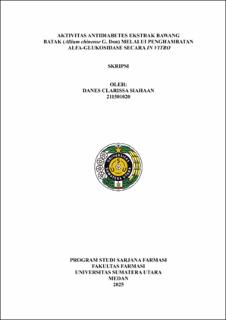| dc.contributor.advisor | Hasibuan, Poppy Anjelisa Zaitun | |
| dc.contributor.author | Siahaan, Danes Clarissa | |
| dc.date.accessioned | 2025-07-22T05:47:17Z | |
| dc.date.available | 2025-07-22T05:47:17Z | |
| dc.date.issued | 2025 | |
| dc.identifier.uri | https://repositori.usu.ac.id/handle/123456789/106146 | |
| dc.description.abstract | Background: Diabetes Mellitus is a chronic disease characterized by elevated blood sugar levels and decreased glucose tolerance. One therapeutic approach involves inhibiting the enzyme α-glucosidase, which plays a key role in the breakdown of carbohydrates into glucose. Batak onion (Allium chinense G. Don), traditionally known for its medicinal properties, is rich in phenolic compounds that are believed to exert antidiabetic effects through α-glucosidase inhibition. The use of Natural Deep Eutectic Solvents (NADES) as extraction solvents offers an innovative and environmentally friendly method to enhance the yield of bioactive compounds.
Objective: This study aimed to investigate the effect of different NADES solvents on the total phenolic content of Batak onion extract. It also aimed to evaluate the in vitro α-glucosidase inhibitory activity of the extract to assess its potential as a natural antidiabetic agent.
Method: An experimental method was employed using Ultrasound-Assisted Extraction (UAE) with five variations of NADES solvents. Total phenolic content was determined using the Folin-Ciocalteu method. The α-glucosidase inhibitory activity was assessed in vitro using P-Nitrophenyl-α-D-Glucopyranoside (pNPG) as a substrate, with acarbose as the positive control. The IC₅₀ value was calculated from the regression curve between sample concentration and percentage inhibition.
Result: The results demonstrated that the variation of NADES solvents significantly influenced the total phenolic content and α-glucosidase inhibitory activity. The NADES composed of choline chloride:glycerol produced the highest phenolic content and exhibited the strongest α-glucosidase inhibition, with an IC₅₀ value of 164.6805 µg/mL. This was lower than that of the positive control (acarbose), which had an IC₅₀ of 308.8507 µg/mL, indicating a higher antidiabetic potential of the extract.
Conclusion: The extract of Batak onion obtained using choline chloride:glycerol-based NADES showed strong α-glucosidase inhibitory activity, with a lower IC₅₀ value than acarbose. These findings suggest that the extract holds promise as an effective natural antidiabetic agent. | en_US |
| dc.language.iso | id | en_US |
| dc.publisher | Universitas Sumatera Utara | en_US |
| dc.subject | allium chinense G.Don | en_US |
| dc.subject | α-glucosidase | en_US |
| dc.subject | IC50 | en_US |
| dc.subject | NADES | en_US |
| dc.subject | antidiabetic | en_US |
| dc.subject | total phenolic content | en_US |
| dc.title | Aktivitas Antidiabetes Ekstrak Bawang Batak (Allium chinense G. Don) Melalui Penghambatan Alfa-Glukosidase Secara In Vitro | en_US |
| dc.title.alternative | Antidiabetes Activity Of Batak Onion Extract (Allium chinense G.Don) Through In Vitro Inhibition Of Alfa-Glukosidase | en_US |
| dc.type | Thesis | en_US |
| dc.identifier.nim | NIM211501020 | |
| dc.identifier.nidn | NIDN0010067505 | |
| dc.identifier.kodeprodi | KODEPRODI48201#Farmasi | |
| dc.description.pages | 143 Pages | en_US |
| dc.description.type | Skripsi Sarjana | en_US |
| dc.subject.sdgs | SDGs 4. Quality Education | en_US |


